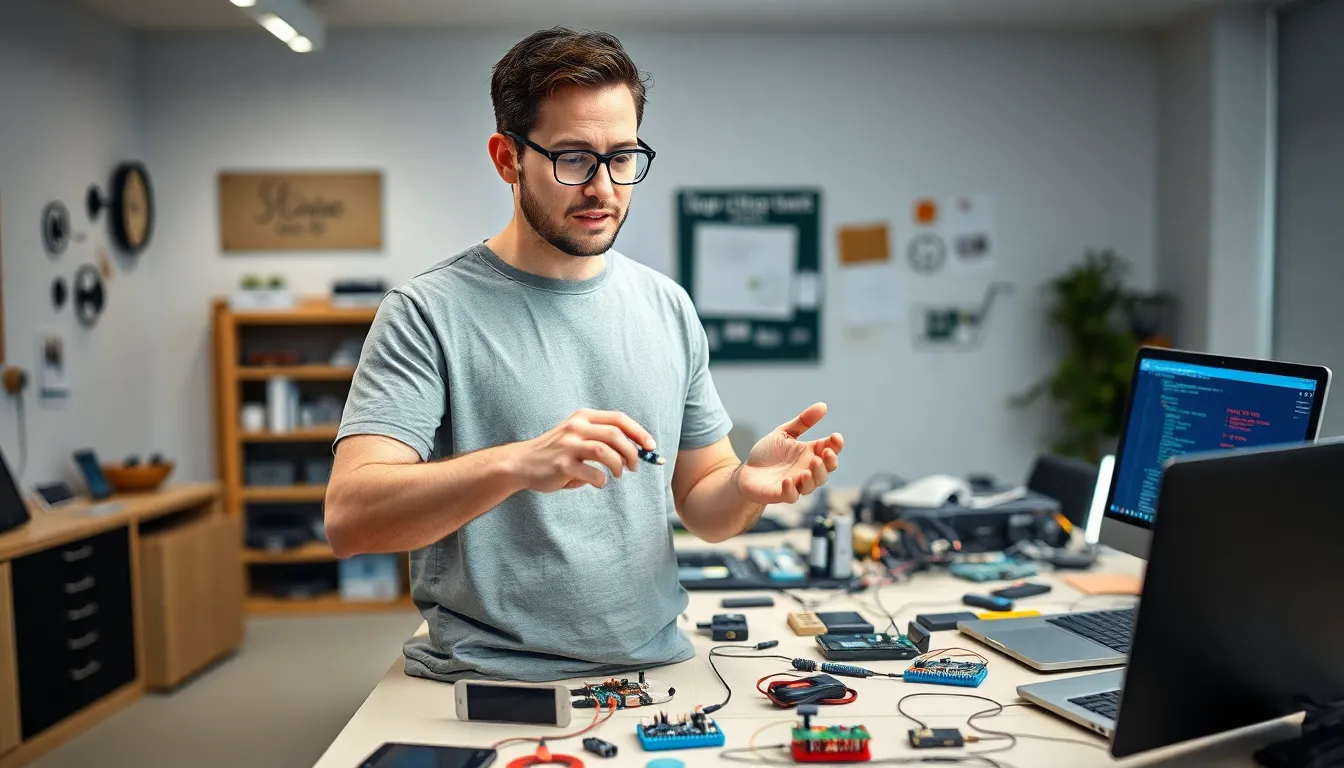In a world where fridges can text you when you’re out of milk and lights can dance to your favorite tunes, the Internet of Things (IoT) is turning everyday life into a sci-fi movie. But don’t worry; you don’t need a PhD in robotics to join the fun. With the right IoT tutorials, anyone can dive into this tech wonderland and start creating their own smart devices that might just make their neighbors a tad jealous.
Table of Contents
ToggleOverview Of IoT Tutorials
IoT tutorials serve as essential resources for individuals interested in exploring the world of smart devices. These tutorials provide step-by-step guidance on creating, programming, and managing IoT applications. Beginners can find materials that cater to varying skill levels, from fundamental concepts to advanced programming techniques.
Many platforms offer free access to comprehensive IoT tutorials. Users can choose from video courses, written guides, and interactive workshops to suit their learning preferences. Popular platforms include Coursera, Udacity, and YouTube, each presenting unique approaches to IoT education.
Tutorials often cover key areas like sensor integration, data collection, and cloud connectivity. Understanding these areas enables learners to grasp how devices communicate and interact with each other. Resources also introduce popular IoT development platforms, including Arduino and Raspberry Pi.
Real-world projects featured in tutorials illustrate practical applications of IoT. Creating projects like smart home systems, weather stations, or health monitors showcases how theory translates into practice. Engaging with these projects helps learners to gain hands-on experience while reinforcing their understanding.
Networking and community support play significant roles in the learning process. Many tutorials encourage participants to join forums and discussion groups where they can exchange ideas, troubleshoot issues, and share successes. Being part of a collaborative environment fosters a deeper connection to the IoT landscape.
Overall, IoT tutorials provide a structured way for individuals to enhance their knowledge and skills. They empower users to innovate in the growing field of smart technology, enabling anyone to become a contributor to the IoT ecosystem.
Types Of IoT Tutorials

IoT tutorials come in various formats to cater to different learning needs. They focus on essential skills for anyone looking to engage with smart technology.
Beginner Tutorials
Beginner tutorials introduce fundamental concepts related to IoT. These resources often cover basic programming languages, device setup, and simple project ideas. Online platforms, including Coursera and YouTube, host these tutorials, making them accessible for anyone without prior experience. Step-by-step instructions guide users through initial projects, such as creating a basic smart light system. Understanding how to connect devices and collect data forms a foundation for more complex projects. Forsaking technical jargon, these tutorials create an inviting atmosphere for newcomers to explore IoT.
Advanced Tutorials
Advanced tutorials target users with prior knowledge of IoT systems. These resources delve deeper into complex topics, such as data analytics and network security. Participants learn to build sophisticated applications, from smart home solutions to industrial IoT systems. Resources from Udacity and specialized workshops allow for hands-on experience with real-world scenarios. Engaging with these materials helps users enhance their programming skills and optimize device performance. Emphasis on integration with cloud services and advanced data management fosters proficiency in managing extensive IoT networks.
Key Topics Covered In IoT Tutorials
IoT tutorials encompass several critical topics that enhance understanding and skills in smart technology. Each area provides valuable insights for users at various stages of expertise.
Device Connectivity
Device connectivity represents a fundamental aspect of IoT. Tutorials focus on various communication protocols such as Wi-Fi, Bluetooth, and Zigbee, which enable devices to interact. Participants learn about setting up devices to ensure they connect smoothly to networks. These resources also cover techniques to troubleshoot common connectivity issues, ensuring robust and reliable performance. Examples include connecting smart bulbs to home networks or linking sensors to cloud platforms for data transmission. Overall, mastering device connectivity is vital for building functional IoT systems.
Data Management and Analysis
Data management and analysis play crucial roles in IoT applications. Tutorials guide users through the processes of data collection, storage, and utilization. Participants explore various data management platforms, enabling efficient handling of large volumes of information. Resources also detail how to analyze data using tools like Python or R, which helps derive meaningful insights from raw data. Analyzing user behavior through collected data empowers the optimization of device functionality. Practical examples, such as monitoring health metrics from wearable devices, illustrate the importance of effective data management in IoT projects. Understanding these principles fosters informed decision-making and enhances project outcomes.
Platforms for Accessing IoT Tutorials
Numerous platforms provide ample access to IoT tutorials, helping individuals explore smart technology with ease.
Online Learning Platforms
Coursera, Udacity, and edX stand out among popular online learning platforms. Each site offers structured courses tailored for various skill levels. Users can access video lectures, assignments, and quizzes to reinforce learning. Topics range from basic programming to advanced network security. Many courses are free, allowing learners to gain knowledge without financial commitment. Enrolling in these platforms often leads to valuable certificates that enhance professional development.
YouTube Channels
YouTube channels dedicated to IoT are abundant and diverse. Channels like The DIY Guy and IoT Inside provide practical demonstrations and tutorials. Searching for specific projects yields a wealth of video content, making it easy to find step-by-step guides. Engaging visuals simplify complex topics, catering to both visual and auditory learners. Many creators interact with their audience through comments, fostering a sense of community and support. Subscribing to these channels ensures continuous access to the latest trends and innovations in the IoT space.
Embracing IoT technology opens up a world of possibilities for everyone. With the right tutorials, anyone can learn to create smart devices that enhance daily life. These resources not only simplify complex concepts but also foster a sense of community among learners.
By engaging with various platforms, individuals can find tutorials that match their skill levels and interests. Whether starting with the basics or delving into advanced topics, the journey into the IoT landscape is both rewarding and accessible.
As the IoT field continues to evolve, staying informed and connected with fellow enthusiasts will ensure ongoing growth and innovation. The future of smart technology is bright, and everyone has a place in it.

